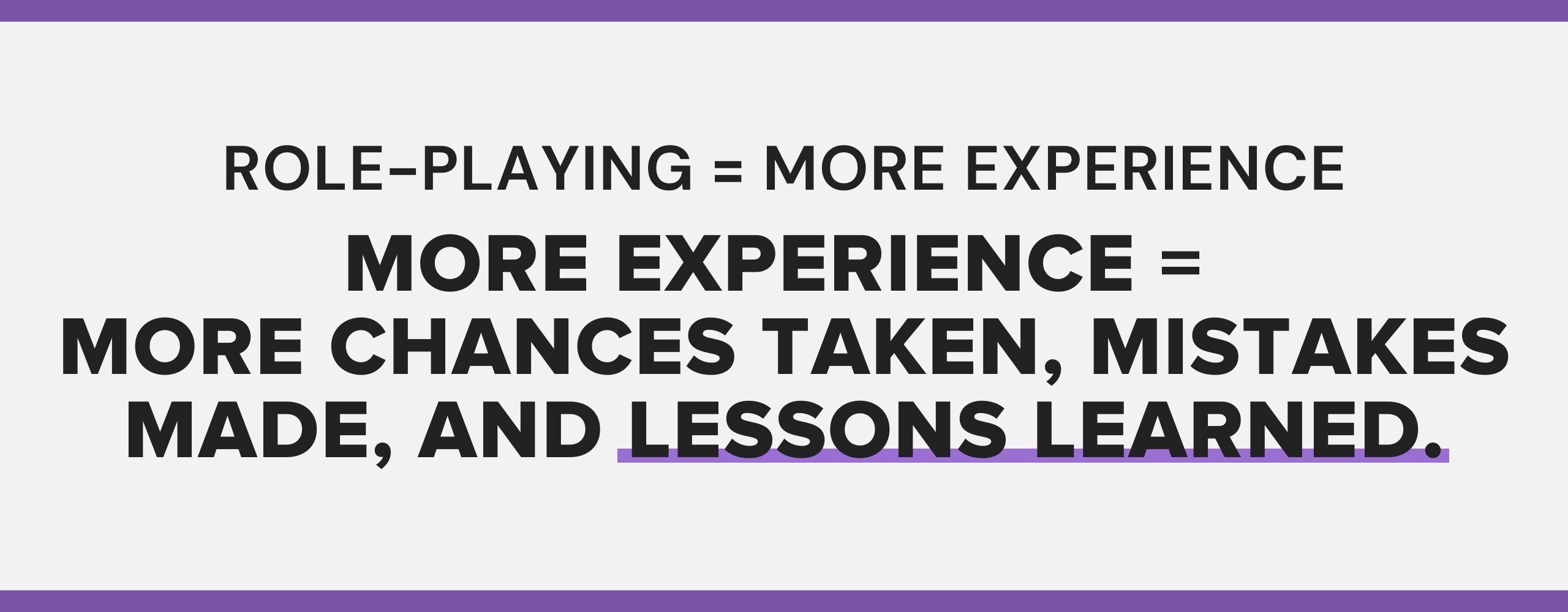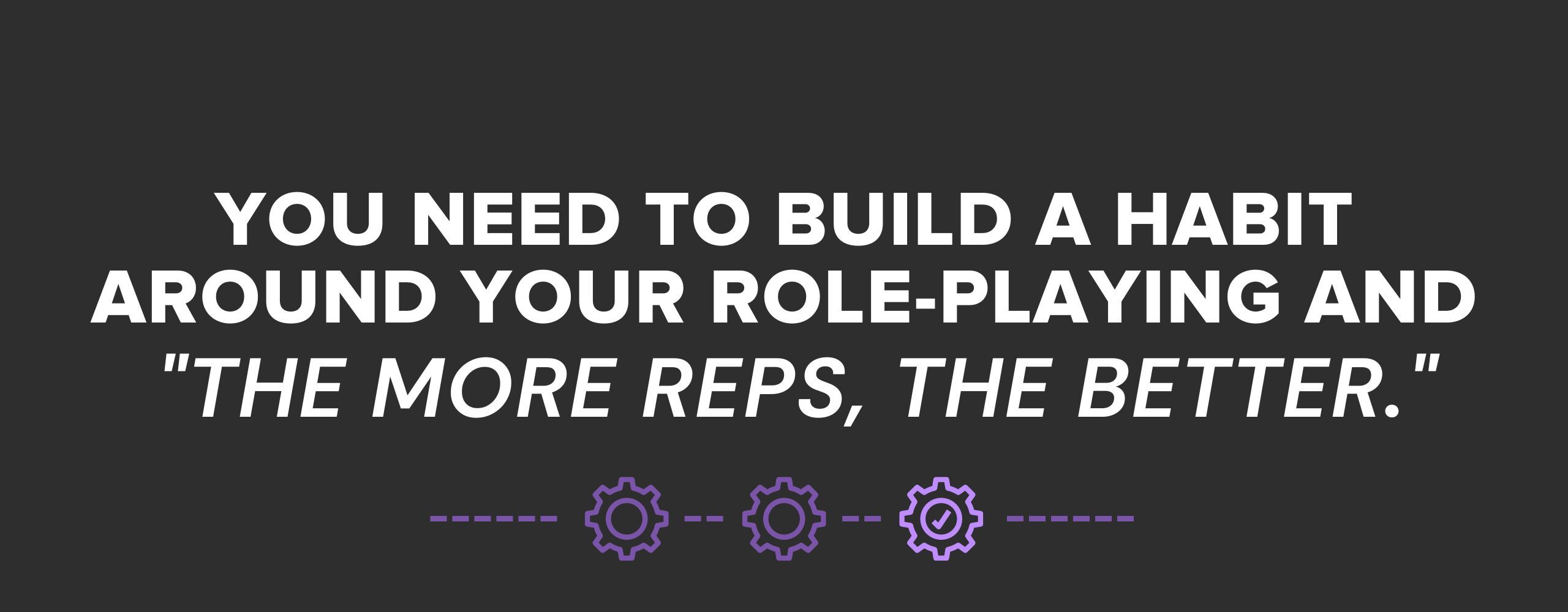Mention role-playing to a group of professionals and the reactions are practically a reflex – sighs, groans, eye-rolls — and those are just the noticeable ones.
Role-plays are a popular development tool used by teams of all kinds and backgrounds, but unfortunately, the cringe felt by participants is just as universal.
“For many people, standing up in front of a group of peers and hearing comments on their performance is painful,” explains Larry J.B. Robinson, a business owner who shared his personal experience with role-playing in HBR.
People are self-conscious about being put on the spot and “performing” in front of a group, let alone having to give and receive feedback. It can be extremely vulnerable.
Heck, I should know. My pulse races and my palms bead up just thinking about it.
On the flip side, even confident performers have said role-playing sales scenarios are too unrealistic, unfocused, and in turn, “a waste of time.”
So, if it’s so miserable, why do people keep doing it?
Our digital sales and marketing coaches have worked with hundreds of sales teams around the world, and the outcome is virtually always the same once we break the bad habits and practices making it a “waste.”

In fact, once taught to do it right, teams we work with find role-playing to be one of the most valuable parts of their sales training.
In this article, I’ll share:
- Why role-playing is so valuable
- What makes role-playing better than other training
- Seven steps to making role-playing more valuable for your sales team
Join the IMPACT coaches for a deep dive on a new topic every month in our free virtual event series.
Why is role-playing so valuable in sales?
Role-playing has been used in sales training for decades — and for good reason.
Effective role-playing helps:
- Enable sales teams to test and refine critical communication techniques in a safe, private environment.
- Allow sales reps to give and receive constructive feedback for improving
- Allow reps to get comfortable with new technology or tools
- Build genuine, lasting confidence
- Improve the sales experience for prospects and customers — ultimately better positioning sales reps to close more deals.
But wait, couldn’t this be done without an awkward performance in front of the team?
Why is role-playing better than other sales training?
In his 1987 article in HBR, Robinson continued:
“Unlike other training tools, such as manuals or classroom lectures, role-playing is active. With the activity, involvement, and peer pressure, people feel in the ‘drama,’ and the learning rate is high.”
What Robinson is describing is the fact that, physiologically, emotions improve memory formation.
In other words, first-hand experiences with physical and sensory engagement — like role-playing — can help sales reps better grasp and remember lessons than other mediums like lectures, articles, or videos.

Role-playing means more experience and more experience means more chances taken, mistakes made, and lessons learned.
With effective role-playing, sales reps get to personally experiment and work through many different types of situations without any risk of failure. They can take a chance without worrying that a deal will be lost or a relationship will be severed.
This practice helps develop the confidence that they know how to respond to any scenario a prospect might throw at them.
So how do you create this dream role-playing that isn’t unfocused, unrealistic, or a waste of time? Here are seven steps for making role-playing actually valuable for your sales team.
1. Choose the right role partner(s)
Think of this step like casting a movie starring you.
If two actors — whether they play love interests, siblings, friends, or enemies — aren’t on the same page, the intended portrayal can’t happen. The audience won’t feel the love, hate, or buddy energy and neither will the actors. You’re looking for on-screen chemistry, in a way.
In the case of sales role-playing, this chemistry comes from a partner who is totally committed to the scenario and helping you improve. They need to be able to clearly articulate:
- What the end goal is
- What calls or meetings are being prepared for
- What scenarios are being worked through
From there, they should be able to grasp what their practicing teammate is trying to work on, what key conditions need to be met, and what that means they should focus on.
Many people might be able to check these boxes, but this role is likely best filled by another sales representative on your sales team or someone from a similar background to the prospect.
These similarities will help a partner step even more firmly into their role in the sales scenario with real-world insights and experiences.
Pro Tip: If possible, have a third party join your role-plays as an observer or mediator.
Having them present will allow you and your partner to fully emerge into the role-play, but also know someone else will be there to keep you on track if you lose course, or even to provide feedback.
Once you have a partner secured, you can start getting to work.
2. Set the conditions
IMPACT Chief Strategy Officer Chris Duprey is our team’s role-play expert.
When he talks to business leaders, sales teams, or even our coaches about how to get started with role-playing, it always starts from the same place: “You have to set the right conditions.”
Follow these ground rules to set the right conditions and mitigate the behaviors and habits that can make role-playing go awry:
- No sarcasm or joking around. As Chris says, “You’re not doing this for laughs. You’re doing this to master your craft.” Participants in role-playing must fully commit to the scenarios being portrayed.
- Have a “read-ahead” written, shared, and agreed upon. (More on that in the next section.)
- Treat each role-play like the real thing. You can’t treat your partner (who may be a friend) as anything other than the role they’re playing. Get into character and stay in character.
In addition to following these ground rules, it’s critical that you center your role-plays around real-life scenarios – for example, sales conversations that are coming up soon with actual prospects.
This will ground you (and/or your team) entirely in reality and again, ensure the techniques practiced will actually come in handy.
If, however, there simply isn’t a real-life scenario you can draw upon, center your role-playing around a selling principle you want to practice.
🎓 Watch Chris’ full course on role-playing: Role-playing virtual selling with sales teams
3. Create and share a “read ahead”
A read-ahead is an outline or document given to the partner who will be acting as the “buyer” in the selling role-play.
It provides them with everything they need to know to be the best partner possible, and with all of the background information they need to make the scenario feel real.
This includes:
- What their character looks like, sounds like, and feels
- What their fears, worries, and concerns are
- Website pages they may have visited and what questions have they answered on forms. (Looking at your CRM will help you find some of these background details.)
- What the first correspondence was before leading to this conversation.
Creating this to share with your partner ahead of time will give them something to use to prepare and also give them the opportunity to ask questions to make the role-play run smoother.
4. Don’t be afraid to pause and start again
If you’re in a role-play and you can feel in the moment that you didn’t handle something as you wanted to, you can “pause and rewind” so you can get it right.
Role-plays are little laboratories for you sales pros, and this is an incredibly effective way to refine your virtual sales communication techniques in real-time, instead of having to wait until after the fact to discuss it.
5. Follow up like a real sales call
So, we’ve already mentioned how important it is to treat these role-plays like real-life scenarios.
Well, that doesn’t end with the sales call or meeting.
If you’re the person acting as the sales rep, complete the full experience of the role-play by sending your “buyer” (your role-play partner) a follow-up email as you would if they were the actual prospect.
Include any videos or follow-up materials and offer next steps just as you normally would. That way, you are able to receive feedback on every aspect of the sales interaction.
6. Debrief and evaluate afterward
Now, this is where the magic happens.
After the role-play, it’s time to dive into how well it went, discussing the original goals, whether or not those goals were achieved, and (if they weren’t) what the opportunities are for improvement to nail it in a real-life situation.
Discuss:
- What were we supposed to do?
- What did we actually do?
- What went well?
- What went wrong?
- What are we going to do to fix it?
As the person practicing, be open to receiving feedback. And, as the partner, be honest with your selling partner about what worked and what didn’t work.
Feedback needs to be caring, but constructive and direct.
What was it about their tone that could have been better? How could they have presented themselves differently?
No one’s perfect. If you walk away from a role-play without places to improve or further learn, you didn’t do what you needed to.
7. Commit to a regular schedule
According to Mindtickle’s State of Sales Readiness 2022, the average company requires sales reps to do 2-3 role-plays per year.
Honestly, we find this to be frighteningly low.
Although there’s no hard and fast rule around how often you should be doing sales role-play, Chris Duprey notes that it’s kind of like exercise.
As the remote-selling landscape continues to evolve, you need to stay “in shape.” You need to build a habit around your role-playing and “the more reps, the better.”

With this in mind, establish a scheduled, frequent rhythm of role-playing virtual sales scenarios. For instance, we recommend clients and those on our own team plan for once a week or once every other week.
Anything less than this, and you likely won’t practice as frequently, let alone learn or remember what you learned between role-plays.
Role-playing is the key to your long-term selling success
As cliche as it sounds, practice really does make perfect.
While it’s never guaranteed that a real sales conversation will go exactly as a role-play, working through different scenarios can help you avoid being thrown or caught off when new situations or objections arise.
And hey, if you encounter something in a conversation you didn’t go over, that’s just a scenario for your next role-play.
Use the steps I outlined above to get started, and if you’d like to dig deeper, check out Chris’s full course, “How to role-play virtual selling with your team” in IMPACT+!


